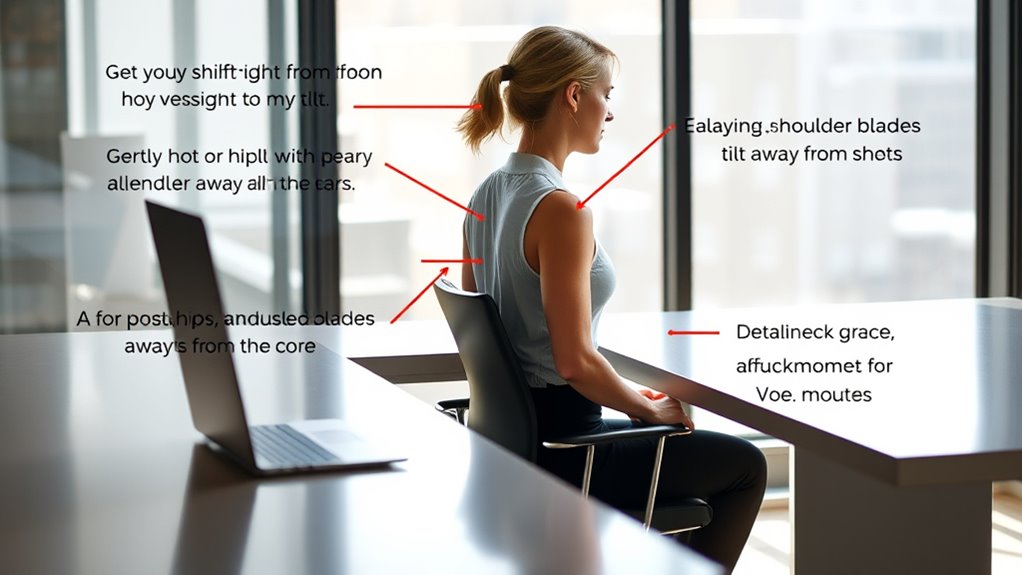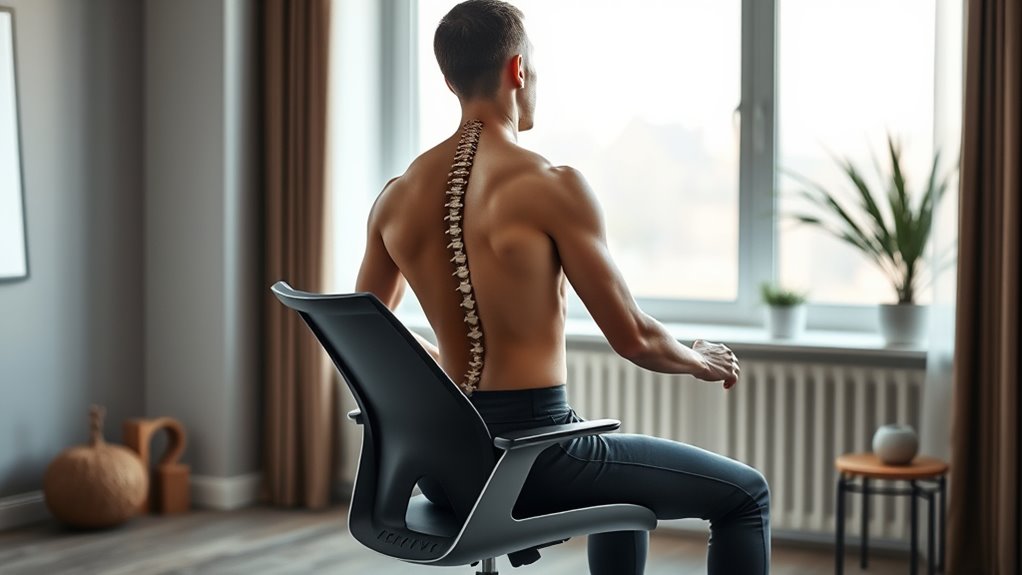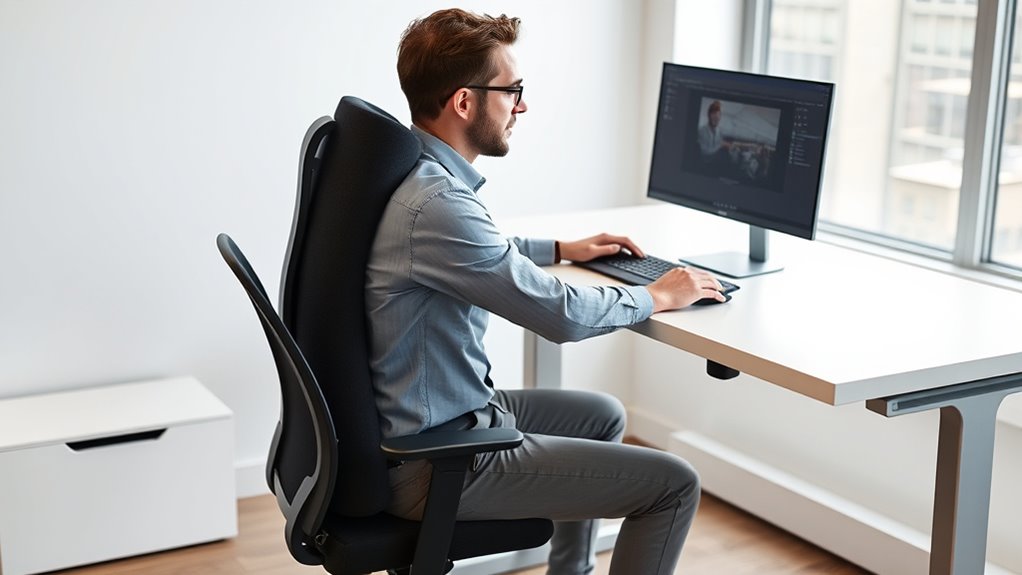To optimize your posture in just 15 minutes, start by adjusting your workspace so your monitor is at eye level and your chair supports your lower back. Incorporate micro-movements like stretching your neck, shoulders, and back, and activate your core to maintain spinal alignment. Use ergonomic accessories and make small adjustments to your chair and screen height. Practice deep breathing to stay mindful of your posture—keep going to discover even more quick tips for comfort and health.
Key Takeaways
- Optimize your workspace with monitor at eye level, supportive chairs, and natural lighting to promote proper posture.
- Incorporate micro-movements like neck rolls and shoulder shrugs every 10-15 minutes to reduce stiffness.
- Engage core muscles and practice diaphragmatic breathing to enhance spinal alignment and relieve tension.
- Maintain feet flat on the ground, relaxed shoulders, and lumbar support for consistent, correct sitting posture.
- Use brief ergonomic adjustments and mindful breathing breaks to sustain focus and prevent long-term discomfort.
Optimize Your Workspace Setup for Instant Posture Benefits

To improve your posture instantly, start by optimizing your workspace setup. Focus on desk ergonomics to ensure your monitor is at eye level, your keyboard is positioned comfortably, and your chair supports your lower back. Proper desk height prevents strain and encourages a natural sitting posture. Additionally, lighting adjustment plays a crucial role; aim for bright, even lighting that reduces eye strain and glare. Position your workspace near a window or use adjustable lamps to create optimal illumination. Keep frequently used items within easy reach to avoid unnecessary stretching or twisting. An organized, ergonomically sound setup encourages good posture habits and minimizes discomfort during long sessions. Making these quick adjustments can substantially enhance your comfort and help maintain proper alignment effortlessly. Incorporating musical cues or calming sounds into your environment can further reduce stress and promote relaxation during work.
Implement Micro-Movements to Break Static Sitting

To avoid stiffness and fatigue, make small adjustments by shifting your weight regularly. Incorporate gentle stretching into your routine to keep your muscles engaged and flexible. These micro-movements help break the cycle of static sitting and boost your comfort throughout the day. Using portable camping chairs with ergonomic support can further enhance your posture and reduce strain during extended sessions.
Shift Your Weight Regularly
Even when you’re sitting for long periods, changing your weight regularly can make a significant difference. Incorporate simple weight shifting to keep your muscles engaged and your circulation flowing. By subtly adjusting your position, you introduce posture variation that prevents stiffness and reduces strain. Avoid staying static in the same position for too long; instead, gently lean forward, backward, or to the sides. These micro-movements help break the habit of static sitting and keep your body active. Regular weight shifting also encourages better alignment, reducing pressure on your lower back and hips. Additionally, selecting the correct bike tire pressure for your terrain can influence how comfortable and supported you feel during activities. Make this a quick habit during your sessions to maintain comfort and prevent fatigue. Small, intentional adjustments go a long way in maintaining your posture and boosting overall comfort.
Incorporate Gentle Stretching
Incorporating gentle stretching into your routine helps break up long periods of static sitting and keeps your muscles active. These micro-movements boost posture awareness and prevent stiffness. To maximize benefits, try:
- Performing shoulder rolls to relieve tension
- Stretching your neck gently side-to-side
- Extending your arms overhead with small, controlled movements
- Twisting your torso while seated to engage core muscles
These simple stretches can be done quickly during breaks, promoting better posture and reducing discomfort. Focus on smooth, deliberate motions that improve circulation and keep you mindful of your alignment. Regularly integrating gentle stretches not only alleviates muscle tightness but also reinforces good posture habits during sessions. Staying aware of AI safety measures is important when considering the integration of new technologies into your workflow. Keep these micro-movements in mind to stay comfortable and alert throughout your workday.
Engage Your Core for Better Spinal Alignment

Before you start sitting or working, activate your core to support your spine. Keep a neutral spine position throughout your activities, and use deep breathing techniques to stay relaxed. These simple steps help improve posture and reduce strain on your back. Incorporating posture correction techniques can further enhance your spinal alignment during sessions.
Activate Core Before Sessions
Engaging your core muscles before each session is essential for maintaining proper spinal alignment and reducing the risk of injury. Core activation helps you build posture awareness, ensuring your body stays supported during movement. To activate your core effectively, try these quick tips:
- Take a deep breath and gently pull your belly button toward your spine.
- Engage your abdominal muscles without holding your breath.
- Maintain this activation as you prepare for your session.
- Focus on sustained, controlled movements to reinforce posture awareness.
- Incorporate posture correctors into your routine to further support spinal alignment and enhance core engagement.
Maintain Neutral Spine Position
Maintaining a neutral spine position is key to supporting proper posture and preventing strain during movement. When you sit, ensure your ergonomic chair supports your lumbar curve, keeping your spinal alignment intact. Engage your core muscles to stabilize your spine and avoid slouching. This helps distribute weight evenly and reduces pressure on your discs. Incorporating protective styling benefits can also help minimize unnecessary strain on your neck and back muscles.
| Tip | Why it Matters |
|---|---|
| Sit with feet flat | Promotes balanced spinal alignment |
| Keep shoulders relaxed | Prevents upper back tension |
| Use lumbar support | Maintains natural spinal curve |
| Engage core muscles | Stabilizes your neutral spine |
| Avoid crossing legs | Keeps pelvis aligned |
Prioritize these tips during sessions to support your spine and maintain comfort effortlessly.
Incorporate Breathing Techniques
Incorporating proper breathing techniques can substantially enhance your core engagement and help you maintain better spinal alignment throughout the day. Focusing on diaphragmatic breathing and breath awareness allows you to activate your deep abdominal muscles, supporting good posture. When you breathe deeply into your belly, you improve stability and reduce tension. To maximize benefits, try these strategies:
- Practice diaphragmatic breathing during quick pauses
- Maintain breath awareness to stay mindful of your posture
- Inhale slowly through your nose, filling your belly first
- Exhale fully to engage your core and release tension
- Remember that natural materials like linen and wood can also promote a calming environment that supports better posture awareness.
Use Ergonomic Accessories to Support Proper Posture

Using ergonomic accessories can make a significant difference in supporting proper posture throughout your workday. Items like adjustable chair cushions, lumbar supports, and monitor stands help align your spine and reduce strain. Ergonomic accessories are designed to promote better posture support by encouraging proper seating angles and reducing pressure on your neck and back. For example, a supportive chair or footrest can prevent slouching and improve circulation. Positioning your monitor at eye level with a stand minimizes neck strain. These small adjustments ensure your body stays in a healthy, neutral position even during long sessions. Incorporating ergonomic accessories into your workspace is a quick, effective way to maintain good posture and prevent discomfort, making your sessions more comfortable and productive. Additionally, understanding Chevrolet Tuning techniques can inspire you to customize your workspace for optimal ergonomics.
Practice Quick Stretching Exercises to Release Tension

After setting up your ergonomic workspace, taking a moment to practice quick stretching exercises can markedly reduce built-up tension. These exercises boost posture awareness and provide effective tension relief during sessions. Incorporate essential oils for tension relief, such as lavender or peppermint, into your routine by diffusing them nearby to enhance relaxation and focus. Try incorporating these simple moves:
- Neck rolls to loosen tightness and prevent stiffness
- Shoulder shrugs to release shoulder tension
- Seated spinal twists to improve posture awareness
- Wrist stretches to reduce strain from prolonged typing
Perform each for about 10-15 seconds, focusing on smooth, controlled movements. These quick stretches help you stay alert, minimize discomfort, and maintain good posture throughout your session. Implementing these exercises regularly ensures tension doesn’t build up, keeping you comfortable and focused. Remember, brief breaks for stretching are essential for posture health and overall well-being during work or study sessions.
Adjust Your Screen and Chair Height for Neutral Positioning

To maintain a neutral and comfortable posture, you should adjust your screen and chair height so your eyes are level with the top of your monitor and your feet rest flat on the floor. This is a key ergonomic adjustment that supports a neutral posture, reducing strain on your neck and back. Position your chair so your hips are slightly higher than your knees, and ensure your monitor is directly in front of you at eye level. When your screen is at the right height, you won’t need to tilt your head up or down, minimizing tension. Proper ergonomic adjustments promote better alignment, prevent discomfort, and help you sustain focus during sessions. Taking a quick moment to fine-tune your setup makes a significant difference in maintaining health and productivity.
Incorporate Mindful Breathing to Enhance Postural Awareness

Incorporating mindful breathing into your daily routine can substantially enhance your awareness of posture. When you focus on your breath, you become more attuned to how your body holds itself, making it easier to identify and correct poor alignment. Practicing mindful breathing during sessions helps you stay present and reduces tension that may lead to slouching or stiffening. To boost postural awareness, try these techniques:
- Take slow, deep breaths to reset tension.
- Pause and check your posture after each inhale.
- Use breath awareness as a reminder to adjust your sitting position.
- Incorporate brief breathing exercises during breaks.
Frequently Asked Questions
How Can I Maintain Good Posture During Long Virtual Meetings?
To maintain good posture during long virtual meetings, you should set up an ergonomic desk setup that supports your back and keeps your monitor at eye level. Take regular breaks to stretch and perform wrist flexibility exercises to reduce strain. Sit with your feet flat on the floor, keep your shoulders relaxed, and avoid slouching. Staying mindful of your posture helps prevent discomfort and keeps you focused throughout the session.
Are There Specific Exercises for Neck and Shoulder Tension Relief?
You can relieve neck and shoulder tension by doing simple stretching routines and adjusting your ergonomic chair. Try neck tilts, shoulder rolls, and neck stretches to loosen tight muscles. Make sure your chair supports your lower back, keeps your feet flat on the ground, and your screen at eye level. These small adjustments and stretches during breaks can considerably reduce tension and improve comfort during long sessions.
How Often Should I Check My Posture During Work Sessions?
You should check your posture every 15 to 30 minutes to stay aligned and comfortable. Use ergonomic accessories like adjustable chairs and monitor stands to support good posture, and leverage posture reminder apps to prompt regular checks. Staying proactive helps prevent tension buildup, reduces discomfort, and promotes overall well-being during work sessions. Consistently monitoring ensures your posture remains ideal, making your workday healthier and more productive.
Can Posture Tips Improve Overall Productivity and Focus?
Yes, improving your posture through ergonomics awareness and posture correction techniques can boost your overall productivity and focus. When you actively maintain proper alignment, you reduce discomfort and distractions, enabling you to concentrate better on tasks. Incorporate quick posture checks, adjust your workspace ergonomics, and practice posture correction techniques regularly. These small but consistent efforts help you stay alert, work efficiently, and prevent fatigue during long sessions.
What Signs Indicate My Posture Needs Immediate Correction?
Did you know that poor posture can cause up to 60% of musculoskeletal issues? You’ll want to watch for signs like persistent neck or back pain, tingling in your arms, or headaches. If these occur, it’s time to boost posture awareness and consider ergonomic accessories such as adjustable chairs or lumbar supports. Immediate correction helps prevent long-term problems and keeps you comfortable and focused during sessions.
Conclusion
By weaving these quick posture wins into your session, you’re sculpting a fortress of well-being amid the chaos. Think of your body as a delicate garden—each mindful adjustment a tender tendril guiding growth. With just 15 minutes, you’re planting seeds of awareness and nurturing resilience. Embrace these simple shifts like a seasoned gardener tending fragile blooms, and watch your posture flourish into a sturdy, graceful landscape that supports you long after the session ends.









